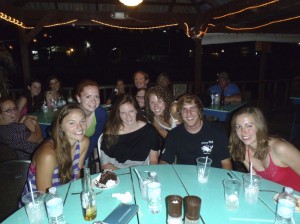Today was our last full day in Culebra, and we certainly made the most of every moment. After a full night of searching for nesting leatherbacks, we headed out on the boats again. But this time, we were searching for hawksbills at Carlos Rosario national park!
At the start of our journey we split into two groups on separate boats. Each member of a group swam parallel to each other, combing over the coral reef in parallel transects. When we spotted a sea turtle, the rest of the group was quickly alerted so that we could learn how to catch free-swimming turtles. At the end of the hour swim, one group caught a hawksbill while the other group caught a green!
Abi: It was amazing to see one of the experienced research technicians (Scooby) free dive down 15ft and snatch a hawksbill before it even knew he was there!
Angela: Green turtles are known for their fast paced swimming, but Carlos dove down almost 30 ft to catch the turtle like it was nothing!

Once the two turtles were caught and aboard the boats, we continued the process of tagging, measuring, and examining their body condition. Once this process was finished, we released them back to the big blue again!

The hawksbill’s appearance was noticeably different than the green sea turtle’s. First off, hawksbills have overlapping scutes on their carapace (their shell) that resemble shingles.

Hawksbills also have a prominent sharp beak that they use to consume their favorite prey, sponges and corals (heavy on the sponges). Compare the hawksbill’s beak to the green sea turtle below (hawksbill photo on top, green on bottom):


This prey preference has led to the phrase “they have a diet of glass.” Many sponges have a silica skeleton, which is essentially glass. Few other species feed on sponges, except for some fish, so there is little competition for this food source. Additionally, this specialized diet enables the hawksbill to fulfill an important ecosystem role as reef remodelers. Sponges secrete a toxin that prevents corals from settling. By eating the sponges, the hawksbill increases the biodiversity of the coral reef! The hawksbills are also reef architects in that they rub up against the reef, structuring it as they move.
After our afternoon fieldwork, we returned to the house to quickly shower before heading out to Mamacita’s for a delicious dinner by the water. We then returned again to the house to pack before our 6 am ferry to the big island the next morning. What an awesome day! We hope to see more hawksbills in the future!

Check out some pictures of us with the turtles we caught today! The first picture has both the hawksbill (left) and green (right) sea turtles. The next four pictures are of the green sea turtle and the last four pictures are of the hawksbill:









Abigail Kucher and Angela Woods
